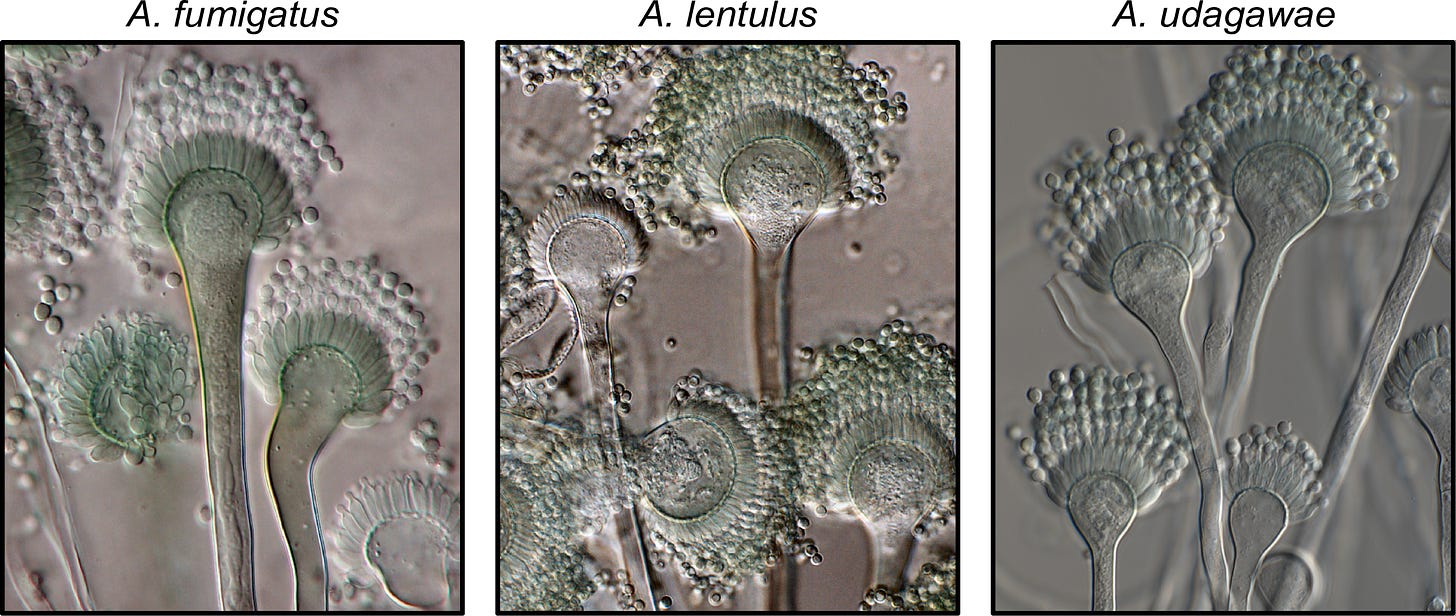Addressing Cryptic Fungal Pathogens for a Healthier Future
Combatting and preventing fungal diseases
The following article is a synopsis of a recent publication in PLOS Pathogens, a scientific journal dedicated to open access sharing of scientific findings.
See Steenwyk et al. (2023) for the full text.
“If you know the enemy and know yourself, you need not fear the result of a hundred battles. If you know yourself but not the enemy, for every victory gained you will also suffer a defeat. If you know neither the enemy nor yourself, you will succumb in every battle.”
—Sun Tzu, The Art of War
Fungal pathogens pose a growing threat to human welfare, impacting health, agriculture, and food security. Understanding these hidden enemies is crucial to preventing and combatting the diseases they cause. However, research of these pathogens has been hindered because they are challenging to detect, diagnose, and treat. Here, we explore the world of cryptic fungal pathogens and the strategies to mitigate their impact on human welfare.
1) Know the Enemy: Accurate Diagnosis is Key
Accurate diagnosis is the first line of defense against fungal pathogens. Traditional diagnostic methods, while helpful, lack specificity, especially for cryptic pathogens, which are defined as being morphologically similar (see figure for examples).

Despite similarities, cryptic pathogens can often be phenotypically distinct in ways that may impact their ability to cause disease. Molecular typing, such as phylogenetic analysis, has proven more accurate in identifying these species. In some cases, genome sequencing is necessary for accurate identification. Developing more rapid and cost-effective diagnostic methods is crucial for lowering mortality rates.
2) Know Yourself: Understanding Human Influence
Human activities, such as construction, water damage, and indoor air quality, can unwittingly contribute to the spread of fungal diseases. Antifungal resistance can also be linked to the widespread use of fungicides in agriculture. Genetic backgrounds and immune system function play a role in disease susceptibility, and specific patient populations are more at risk. Understanding these factors is crucial for preventing and treating fungal infections.
3) Know the Enemy and Know Yourself: Immune Response Insights
Studying the interaction between fungal pathogens and the host's immune system is essential. It provides insights into how pathogens are recognized and cleared from the body. Different infections require different immune responses, so understanding the site of infection is critical. Immune cells can also have a direct impact on microbial clearance, with genetic variations playing a significant role in susceptibility.
4) Beyond the Bipartite: The Microbiome's Role
The human microbiome, including the mycobiome (the fungal component), plays a crucial role in disease clearance and persistence. Imbalances in the mycobiome can exacerbate certain diseases. Understanding species-level variations within the microbiome and the influence of pathogens on it can lead to new therapeutic approaches. Coinfections of multiple pathogens are being recognized, emphasizing the complexity of species-species interactions.
5) Identifying Future Threats and Evolution of Pathogenesis
Studying non-pathogenic species is also crucial as they may emerge as disease-causing agents in clinical contexts. This broader understanding of fungal lifestyles can help identify species with potential pathogenic traits. Additionally, factors like climate change may predispose certain fungi to thrive at human body temperature, raising concerns about future threats.
Conclusion: Embracing Complexity for a Healthier Future
Addressing the challenges of cryptic fungal pathogens requires infrastructure for accurate diagnostic testing and data dissemination. This infrastructure will help monitor disease burden, understand pathogen epidemiology, and identify early outbreaks. Integrating various data dimensions, including host genetics, electronic health records, microbiome, and pathogen data, will provide a comprehensive dataset for researchers worldwide to tackle the fungal pathogen problem.
In our battle against these hidden fungal foes, knowledge and collaboration are our most potent weapons. Understanding these pathogens and their complex interactions with humans and the environment is the key to a healthier future.




